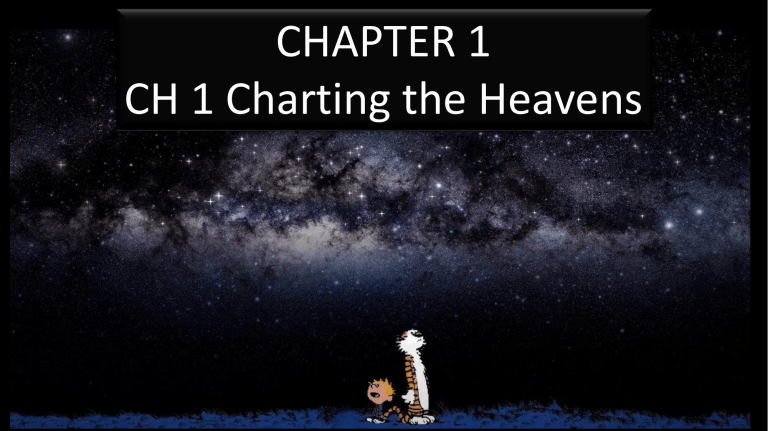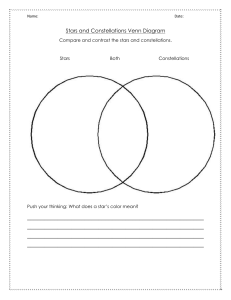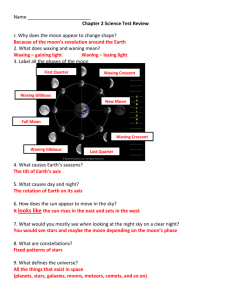
CHAPTER 1 CH 1 Charting the Heavens 1.1 Our Place in Space – Earth, Sun, Milky Way, and Life We are not that special. (video) - Earth is just an ordinary rocky planet - Earth is one of 8 planets orbiting the Sun - The Sun is an average star, near the edge of a huge collection of stars called the Milky Way Galaxy - The MW Galaxy is just one galaxy among billions of others We are not that special. - Humans are made of chemicals (hydrogen, oxygen, carbon, etc.) that were created billions of years ago in stars that became clouds of gases. - The clouds of gases collapsed to make new stars (like the Sun) and planets about 4.6 billion years ago. Everything on Earth is made from atoms that came from other parts of the universe long before humans existed. “If we are composed of matter from the universe, then if there are other beings they must share our cosmic origin.” Universe = all space, all time, all matter, all energy that exists as we know it Astronomy = study of that universe Universe = 100,000 light-years in diameter Light year = distance traveled by light in a year, at a speed of about 300,000 km/sec 1 light-year = 10 trillion km What is a trillion? At the rate of 1 number per second you can… Count to 100 in about ____ seconds. Count to 1 thousand in about 16 minutes. Count to 1 million in about 2 weeks. Count to 1 billion in about 50 years. (1/2 human life) Count to 1 trillion in about 32,000 years (start in ice age) Smaller answer + to left M mega 106 .0045 Mm k kilo .045 km 103 h hecto .45 hm 102 4.5 dam da deka 101 Larger answer - to left meter base 45 m d deci 10-1 450 dm c centi 10-2 4500 cm m milli 10-3 45000 mm - Scientific Notation – based on 10 101 10 = 100 = 102 1000 = 103 104 = 10000 105 = 100000 106 = 1000000 2.5 x 102 = 250 2.54 x 102 = 254 2.54 x 105 = 254000 Negatives: 0.1 = 10-1 0.01 = 10-2 0.00025 = 2.5 x 10-4 7.3 x 10-3 = 0.0073 ASSIGNMENT: Scientific Notation WS Memorize: 3-6-9-12 1 thousand = 103 1 million = 106 1 billion = 109 1 trillion = 1012 Subatomic particles = 0.0000000000000001 meter (1 x 10-16) Galaxy (average) = 1,000,000,000,000,000,000,000 meters across (1 x 1021) Farthest objects in Universe = 100,000,000,000,000,000,000,000,000 meters away (1 x 1026) 1.2 Scales of the Universe (Khan Academy Series) https://www.khanacademy.org/teacher/class/RRWXQFQV/create-assignments The Ever-Expanding Universe 3-4 cm dots Step 1: Blow up your balloon to about 3-4 cm in diameter. DO NOT TIE YOUR BALLOON – LET YOUR PARTNER HOLD IT. Step 2: Draw a small cluster of dots on one side of the balloon. ? Step 3: Blow up your balloon more and watch what happens to the dots. 1.3 The “Obvious” View – The Celestial Sphere Constellations don’t move across the sky from east to west, but they look like they do! Early astronomers concluded that the stars must be attached to a dome/sphere that spun slowly around the Earth (which was still). All stars appear to move in circles around a point close to Polaris. Movement of stars is actually due to the rotation/spin of Earth. Revolution – Time it takes a planet to make a complete revolution around its star (1 Year) Rotation – Spin of a planet on its axis (1 day) 1.3 The “Obvious” View – The Celestial Sphere Early astronomers concluded that the stars must be attached to a dome/sphere that spun slowly around the Earth (which was still). All stars appear to move in circles around a point close to Polaris. North celestial pole Sun Ecliptic Celestial equator Equator South celestial pole 1.3 The “Obvious” View – Constellations What we think we see. What we actually see. LAB Modeling constellations 1.3 The “Obvious” View – Constellations The Big Dipper LAB Modeling constellations North 1.3 The “Obvious” View – Constellations 1.3 The “Obvious” View – Constellations Fundamental Forces of Universe Weak radioactive decay force Name that Force! Strong nuclear force Name that Force! Electromagnetic force Name that Force! Gravitational force Name that Force! 1.4 Day-to-Day Solar Day – noon to noon Sidereal Day – Earth’s true rotational period (slight difference from solar day) Earth rotates at the same rate as it revolves. From one sidereal to the next, Earth revolves 1o farther. Solar day exceeds the sidereal day by about 4 minutes https://www.youtube.com/watch?v=RrIonLndbQ4 1.4 Earth – Seasonal Changes 1. Draw a large circle on your table. 2. Gently tape your Earth to your protractor with the poles straight up and down. 3. With the protractor/earth upright, place the earth at each of the solstices and equinoxes. 4. Does the light from the sun change it’s primary position above or below the equator? Vernal equinox Mar 21 Summer solstice June 21 Winter solstice Dec 21 Autumnal equinox Sep 21 1.4 Milankovitch’s Orbital Cycles – Long-Term Changes Milankovitch - Earth’s position and tilt relative to the Sun Strong drivers of Earth’s long-term climate Responsible for triggering beginning/end of global warming and ice Ages. Three Milankovitch cycles 1.The shape of Earth’s orbit, known as eccentricity Currently, Earth’s eccentricity is near its least elliptic (most circular) and is very slowly decreasing Three Milankovitch cycles 2. The angle Earth’s axis is tilted with respect to Earth’s orbital plane, known as obliquity 41,000 year cycle 41,000 year cycle Earth – Seasonal Changes Seasons are due to the tilt and revolution of Earth. Spring, Summer, Autumn, Winter 23.5o tilt 5. Place your Earth ball on the table with the poles straight up and down. 6. Using your protrator, tilt your Earth 23.5o 7. Gently and lightly tape your Earth to the compass in this position. 8. Repeat your placement of Earth on the circle. What do you notice? 23.5o • Earth’s axis is currently tilted 23.4 degrees, or about half way between its extremes, and this angle is very slowly decreasing in a cycle that spans about 41,000 years. • It was last at its maximum tilt about 10,700 years ago and will reach its minimum tilt about 9,800 years from now. • As obliquity decreases, it gradually helps make our seasons milder, resulting in increasingly warmer winters, and cooler summers that gradually, over time, allow snow and ice at high latitudes to build up into large ice sheets. • As ice cover increases, it reflects more of the Sun’s energy back into space, promoting even further cooling. Three Milankovitch cycles 3. Earth wobbles slightly on its axis due to tidal forces caused by the gravitational influences of the Sun and Moon. Tops 1.5 The Motion of the Moon – Lunar Phases 3 Waxing – sunny side is on the right Waning – sunny side is on the left 4 QUIZ TOMORROW! 2 5 1 6 8 7 1.5 The Motion of the Moon – Eclipses Lunar Eclipse – Line-up: Sun – Earth - Moon Refracted Shade (bent by Earth’s atmosphere Penumbra Complete Shade Numbra Penumbra Refracted Shade (bent by Earth’s atmosphere 1.5 The Motion of the Moon – Super, Blood, and Blue Moons • Super Moon • Full moon • At perigee • Appears larger/brighter • Blood Moon • Atmospheric effect during penumbra • Moon appears reddish • Blue Moon • Second full moon in one month • Every 2-3 years • Not blue 1.5 The Motion of the Moon – Triangulation and Parallax Angles • Triangulation = a method to measure distance without going from origin to target • Parallax Angle = an imaginary triangle extending from Earth to a nearby object in space. Assignment: CH 1 HOMEWORK (Link is on Google Classroom) ALL ASSIGNMENTS ARE DUE THE NEXT DAY!





